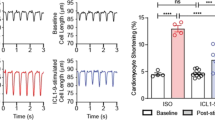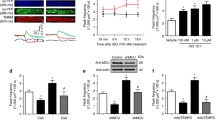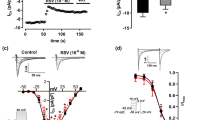Abstract
Phosphodiesterase type 5A (PDE5A) inhibitors acutely suppress beta-adrenergic receptor (β-AR) stimulation in left ventricular myocytes and hearts. This modulation requires cyclic GMP synthesis via nitric oxide synthase (NOS)-NO stimulation, but upstream and downstream mechanisms remain un-defined. To determine this, adult cardiac myocytes from genetically engineered mice and controls were studied by video microscopy to assess sarcomere shortening (SS) and fura2-AM fluorescence to measure calcium transients (CaT). Enhanced SS from isoproterenol (ISO, 10 nM) was suppressed ≥50% by the PDE5A inhibitor sildenafil (SIL, 1 μM), without altering CaT. This regulation was unaltered despite co-inhibition of either the cGMP-stimulated cAMP-esterase PDE2 (Bay 60-7550), or cGMP-inhibited cAMP-esterase PDE3 (cilostamide). Thus, the SIL response could not be ascribed to cGMP interaction with alternative PDEs. However, genetic deletion (or pharmacologic blockade) of β3-ARs, which couple to NOS signaling, fully prevented SIL modulation of ISO-stimulated SS. Importantly, both PDE5A protein expression and activity were similar in β3-AR knockout (β3-AR−/−) myocytes as in controls. Downstream, cGMP stimulates protein kinase G (PKG), and we found contractile modulation by SIL required PKG activation and enhanced TnI phosphorylation at S23, S24. Myocytes expressing the slow skeletal TnI isoform which lacks these sites displayed no modulation of ISO responses by SIL. Non-equilibrium isoelectric focusing gel electrophoresis showed SIL increased TnI phosphorylation above that from concomitant ISO in control but not β3-AR−/− myocytes. These data support a cascade involving β3-AR stimulation, and subsequent PKG-dependent TnI S23, S24 phosphorylation as primary factors underlying the capacity of acute PDE5A inhibition to blunt myocardial β-adrenergic stimulation.






Similar content being viewed by others
References
Borlaug BA, Melenovsky V, Marhin T, Fitzgerald P, Kass DA (2005) Sildenafil inhibits beta-adrenergic-stimulated cardiac contractility in humans. Circulation 112:2642–2649
Bremer YA, Salloum F, Ockaili R, Chou E, Moskowitz WB, Kukreja RC (2005) Sildenafil citrate (viagra) induces cardioprotective effects after ischemia/reperfusion injury in infant rabbits. Pediatr Res 57:22–27
Brixius K, Bloch W, Ziskoven C, Bolck B, Napp A, Pott C, Steinritz D, Jiminez M, Addicks K, Giacobino JP, Schwinger RH (2006) Beta3-adrenergic eNOS stimulation in left ventricular murine myocardium. Can J Physiol Pharmacol 84:1051–1060
Castro LR, Verde I, Cooper DM, Fischmeister R (2006) Cyclic guanosine monophosphate compartmentation in rat cardiac myocytes. Circulation 113:2221–2228
Ding B, Abe J, Wei H, Huang Q, Walsh RA, Molina CA, Zhao A, Sadoshima J, Blaxall BC, Berk BC, Yan C (2005) Functional role of phosphodiesterase 3 in cardiomyocyte apoptosis: implication in heart failure. Circulation 111:2469–2476
Dostmann WR, Taylor MS, Nickl CK, Brayden JE, Frank R, Tegge WJ (2000) Highly specific, membrane-permeant peptide blockers of cGMP-dependent protein kinase Ialpha inhibit NO-induced cerebral dilation. Proc Natl Acad Sci USA 97:14772–14777
Fischmeister R, Castro LR, Abi-Gerges A, Rochais F, Jurevicius J, Leroy J, Vandecasteele G (2006) Compartmentation of cyclic nucleotide signaling in the heart: the role of cyclic nucleotide phosphodiesterases. Circ Res 99:816–828
Fisher PW, Salloum F, Das A, Hyder H, Kukreja RC (2005) Phosphodiesterase-5 inhibition with sildenafil attenuates cardiomyocyte apoptosis and left ventricular dysfunction in a chronic model of doxorubicin cardiotoxicity. Circulation 111:1601–1610
Gauthier C, Leblais V, Kobzik L, Trochu JN, Khandoudi N, Bril A, Balligand JL, Le Marec H (1998) The negative inotropic effect of beta3-adrenoceptor stimulation is mediated by activation of a nitric oxide synthase pathway in human ventricle. J Clin Invest 102:1377–1384
Gauthier C, Seze-Goismier C, Rozec B (2007) Beta 3-adrenoceptors in the cardiovascular system. Clin Hemorheol Microcirc 37:193–204
Kobayashi T, Jin L, de Tombe PP (2008) Cardiac thin filament regulation. Pflugers Arch 457:37–46
Kobayashi T, Yang X, Walker LA, Van Breemen RB, Solaro RJ (2005) A non-equilibrium isoelectric focusing method to determine states of phosphorylation of cardiac troponin I: identification of Ser-23 and Ser-24 as significant sites of phosphorylation by protein kinase C. J Mol Cell Cardiol 38:213–218
Kooij V, Boontje N, Zaremba R, Jaquet K, Dos RC, Stienen GJ, van der Velden (2009) Protein kinase C alpha and epsilon phosphorylation of troponin and myosin binding protein C reduce Ca(2+) sensitivity in human myocardium. Basic Res Cardiol. doi:10.1007/s00395-009-0053-z
Layland J, Li JM, Shah AM (2002) Role of cyclic GMP-dependent protein kinase in the contractile response to exogenous nitric oxide in rat cardiac myocytes. J Physiol 540:457–467
Leroy J, Abi-Gerges A, Nikolaev VO, Richter W, Lechene P, Mazet JL, Conti M, Fischmeister R, Vandecasteele G (2008) Spatiotemporal dynamics of beta-adrenergic cAMP signals and L-type Ca2+ channel regulation in adult rat ventricular myocytes: role of phosphodiesterases. Circ Res 102:1091–1100
Marston SB, de Tombe PP (2008) Troponin phosphorylation and myofilament Ca2+-sensitivity in heart failure: increased or decreased? J Mol Cell Cardiol 45:603–607
Martinez SE, Wu AY, Glavas NA, Tang XB, Turley S, Hol WG, Beavo JA (2002) The two GAF domains in phosphodiesterase 2A have distinct roles in dimerization and in cGMP binding. Proc Natl Acad Sci USA 99:13260–13265
Massion PB, Dessy C, Desjardins F, Pelat M, Havaux X, Belge C, Moulin P, Guiot Y, Feron O, Janssens S, Balligand JL (2004) Cardiomyocyte-restricted overexpression of endothelial nitric oxide synthase (NOS3) attenuates beta-adrenergic stimulation and reinforces vagal inhibition of cardiac contraction. Circulation 110:2666–2672
Moens AL, Leyton-Mange JS, Niu X, Yang R, Cingolani O, Arkenbout EK, Champion HC, Bedja D, Gabrielson KL, Chen J, Xia Y, Hale AB, Channon KM, Halushka MK, Barker N, Wuyts FL, Kaminski PM, Wolin MS, Kass DA, Barouch LA (2009) Adverse ventricular remodeling and exacerbated NOS uncoupling from pressure-overload in mice lacking the beta3-adrenoreceptor. J Mol Cell Cardiol 47:576–585
Mongillo M, Tocchetti CG, Terrin A, Lissandron V, Cheung YF, Dostmann WR, Pozzan T, Kass DA, Paolocci N, Houslay MD, Zaccolo M (2006) Compartmentalized phosphodiesterase-2 activity blunts beta-adrenergic cardiac inotropy via an NO/cGMP-dependent pathway. Circ Res 98:226–234
Moniotte S, Kobzik L, Feron O, Trochu JN, Gauthier C, Balligand JL (2001) Upregulation of beta(3)-adrenoceptors and altered contractile response to inotropic amines in human failing myocardium. Circulation 103:1649–1655
Nagayama T, Hsu S, Zhang M, Koitabashi N, Bedja D, Gabrielson K, Takimoto E, Kass DA (2009) Sildenafil stops progressive chamber, cellular, and molecular remodeling and improves calcium handling and function in hearts with pre-existing advanced hypertrophy due to pressure-overload. J Am Coll Cardiol 53:207–215
Nagayama T, Zhang M, Hsu S, Takimoto E, Kass DA (2008) Sustained soluble guanylate cyclase stimulation offsets nitric-oxide synthase inhibition to restore acute cardiac modulation by sildenafil. J Pharmacol Exp Ther 326:380–387
Nagendran J, Archer SL, Soliman D, Gurtu V, Moudgil R, Haromy A, St Aubin C, Webster L, Rebeyka IM, Ross DB, Light PE, Dyck JR, Michelakis ED (2007) Phosphodiesterase type 5 is highly expressed in the hypertrophied human right ventricle, and acute inhibition of phosphodiesterase type 5 improves contractility. Circulation 116:238–248
Piggott LA, Hassell KA, Berkova Z, Morris AP, Silberbach M, Rich TC (2006) Natriuretic peptides and nitric oxide stimulate cGMP synthesis in different cellular compartments. J Gen Physiol 128:3–14
Pokreisz P, Vandenwijngaert S, Bito V, Van den BA, Lenaerts I, Busch C, Marsboom G, Gheysens O, Vermeersch P, Biesmans L, Liu X, Gillijns H, Pellens M, Van Lommel A, Buys E, Schoonjans L, Vanhaecke J, Verbeken E, Sipido K, Herijgers P, Bloch KD, Janssens SP (2009) Ventricular phosphodiesterase-5 expression is increased in patients with advanced heart failure and contributes to adverse ventricular remodeling after myocardial infarction in mice. Circulation 119:408–416
Recchia FA, McConnell PI, Bernstein RD, Vogel TR, Xu X, Hintze TH (1998) Reduced nitric oxide production and altered myocardial metabolism during the decompensation of pacing-induced heart failure in the conscious dog. Circ Res 83:969–979
Rozec B, Gauthier C (2006) beta3-adrenoceptors in the cardiovascular system: putative roles in human pathologies. Pharmacol Ther 111:652–673
Salloum FN, Abbate A, Das A, Houser JE, Mudrick CA, Qureshi I, Hoke NN, Roy SK, Brown WR, Prabhakar S (2008) Kukreja RC (2008) Sildenafil (Viagra) Attenuates Ischemic Cardiomyopathy and Improves Left VentricularFunction in Mice. Am J Physiol Heart Circ Physiol 294:H1398–H1406
Satoh S, Makino N (2001) Intracellular mechanisms of cGMP-mediated regulation of myocardial contraction. Basic Res Cardiol 96:652–658
Senzaki H, Smith CJ, Juang GJ, Isoda T, Mayer SP, Ohler A, Paolocci N, Tomaselli GF, Hare JM, Kass DA (2001) Cardiac phosphodiesterase 5 (cGMP-specific) modulates beta-adrenergic signaling in vivo and is down-regulated in heart failure. FASEB J 15:1718–1726
Shah AM, Spurgeon HA, Sollott SJ, Talo A, Lakatta EG (1994) 8-bromo-cGMP reduces the myofilament response to Ca2+ in intact cardiac myocytes. Circ Res 74:970–978
Surapisitchat J, Jeon KI, Yan C, Beavo JA (2007) Differential regulation of endothelial cell permeability by cGMP via phosphodiesterases 2 and 3. Circ Res 101:811–818
Takimoto E, Belardi D, Tocchetti CG, Vahebi S, Cormaci G, Ketner EA, Moens AL, Champion HC, Kass DA (2007) Compartmentalization of cardiac beta-adrenergic inotropy modulation by phosphodiesterase type 5. Circulation 115:2159–2167
Takimoto E, Champion HC, Belardi D, Moslehi J, Mongillo M, Mergia E, Montrose DC, Isoda T, Aufiero K, Zaccolo M, Dostmann WR, Smith CJ, Kass DA (2005) cGMP catabolism by phosphodiesterase 5A regulates cardiac adrenergic stimulation by NOS3-dependent mechanism. Circ Res 96:100–109
Takimoto E, Champion HC, Li M, Belardi D, Ren S, Rodriguez ER, Bedja D, Gabrielson KL, Wang Y, Kass DA (2005) Chronic inhibition of cyclic GMP phosphodiesterase 5A prevents and reverses cardiac hypertrophy. Nat Med 11:214–222
Tsai EJ, Kass DA (2009) Cyclic GMP signaling in cardiovascular pathophysiology and therapeutics. Pharmacol Ther 122:216–238
Varghese P, Harrison RW, Lofthouse RA, Georgakopoulos D, Berkowitz DE, Hare JM (2000) beta(3)-adrenoceptor deficiency blocks nitric oxide-dependent inhibition of myocardial contractility. J Clin Invest 106:697–703
Vila-Petroff MG, Younes A, Egan J, Lakatta EG, Sollott SJ (1999) Activation of distinct cAMP-dependent and cGMP-dependent pathways by nitric oxide in cardiac myocytes. Circ Res 84:1020–1031
Wang H, Kohr MJ, Traynham CJ, Ziolo MT (2009) Phosphodiesterase 5 restricts NOS3/Soluble guanylate cyclase signaling to L-type Ca2+ current in cardiac myocytes. J Mol Cell Cardiol 47:304–314
Wattanapermpool J, Guo X, Solaro RJ (1995) The unique amino-terminal peptide of cardiac troponin I regulates myofibrillar activity only when it is phosphorylated. J Mol Cell Cardiol 27:1383–1391
Wolska BM, Vijayan K, Arteaga GM, Konhilas JP, Phillips RM, Kim R, Naya T, Leiden JM, Martin AF, de Tombe PP, Solaro RJ (2001) Expression of slow skeletal troponin I in adult transgenic mouse heart muscle reduces the force decline observed during acidic conditions. J Physiol 536:863–870
Wu AY, Tang XB, Martinez SE, Ikeda K, Beavo JA (2004) Molecular determinants for cyclic nucleotide binding to the regulatory domains of phosphodiesterase 2A. J Biol Chem 279:37928–37938
Yang L, Liu G, Zakharov SI, Bellinger AM, Mongillo M, Marx SO (2007) Protein kinase G phosphorylates Cav1.2 alpha1c and beta2 subunits. Circ Res 101:465–474
Yasuda S, Coutu P, Sadayappan S, Robbins J, Metzger JM (2007) Cardiac transgenic and gene transfer strategies converge to support an important role for troponin I in regulating relaxation in cardiac myocytes. Circ Res 101:377–386
Zaccolo M (2006) Phosphodiesterases and compartmentalized cAMP signalling in the heart. Eur J Cell Biol 85:693–697
Acknowledgments
We thank Chad M. Warren for his assistance in performing some of the isoelectric gel electrophoresis studies. This work was supported by Public Health Service NHLBI grants: HL-089297, HL-095408 (DAK), and T32 HL-07227 (DAK, SV), and RO1 HL-022231, and PO1-HL-062426 (RJS).
Conflict of interest statement
None.
Author information
Authors and Affiliations
Corresponding author
Additional information
D. I. Lee and S. Vahebi contributed equally to the work.
Electronic supplementary material
Below is the link to the electronic supplementary material.
395_2010_84_MOESM1_ESM.ppt
(A) Sarcomere shortening and corresponding Ca2+ transients in myocytes before and after treatment with the selective PDE2 inhibitor Bay 60-7550 (50 nM). Bay 60-7550, itself, had a no effect on either cell shortening or the Ca2+ transient in control (C57BL/6) myocytes. Example tracings are on left, summary data to the right. (B) Sarcomere shortening and corresponding Ca2+ transients in control myocytes before and after exposure to the PDE3 inhibitor cilostamide (CIL, 1 µM). CIL alone had no effect on either behavior in myocytes. Example tracings are on the left, summary data to the right. (C) (A) PDE3 inhibition alone (CIL) does not alter sarcomere shortening or calcium transients in myocytes lacking the β3-adrenergic receptor. (B) ISO stimulated contraction and calcium transients are unaltered by co-repression of PDE3 in β3 knockout cells. (C) SIL does not significantly alter contraction (nor calcium transients) in β3 knockout cells stimulated with ISO. See text for details (PPT 234 kb)
Rights and permissions
About this article
Cite this article
Lee, D.I., Vahebi, S., Tocchetti, C.G. et al. PDE5A suppression of acute β-adrenergic activation requires modulation of myocyte beta-3 signaling coupled to PKG-mediated troponin I phosphorylation. Basic Res Cardiol 105, 337–347 (2010). https://doi.org/10.1007/s00395-010-0084-5
Received:
Revised:
Accepted:
Published:
Issue Date:
DOI: https://doi.org/10.1007/s00395-010-0084-5




